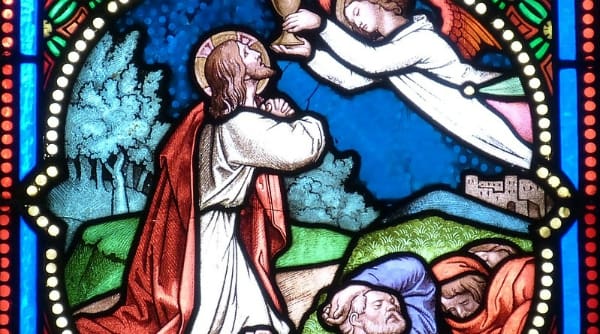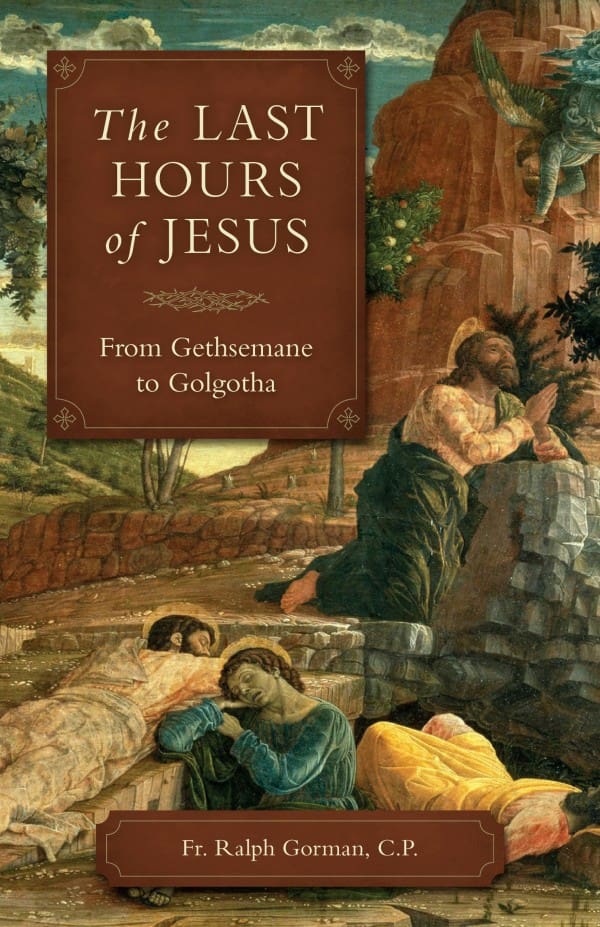At Gethsemane we begin the story of the Passion of Jesus Christ. All that has gone before is as a prologue to this greatest of all dramas. The narrators are the four Evangelists. They all believed in Jesus Christ as a divine person, the true Son of God, and offered their lives in witness of this belief. And yet there is no change in their style as they narrate the awful events of Holy Thursday night and the following day. There is no attempt to remove what was a stumbling block and a scandal to Jews and Gentiles. Through their eyes we see Jesus overwhelmed with fear and sadness; betrayed into the hands of his enemies; hurried from one tribunal to another; mocked, spit upon, scourged, and crowned with thorns; condemned to the death of the cross and left to die, nailed to a gibbet, beyond a gate of the city, beside a highway where passersby could behold what they thought was the welldeserved punishment of the false prophet from Nazareth.
And the Evangelists tell this story simply, objectively, and without any effort to avoid or color the facts. Indeed, we might say that they tell the story coldly. They are historians, recording what happened without expressing sympathy for the suffering Christ or antipathy for His enemies. Their very simplicity and candor and lack of special pleading give a tremendous and moving eloquence to these greatest pages of Holy Writ.
The Evangelists are sparing in details describing the places where events in our Lord’s life occurred. The Gospels were written for the early Christians; information of this kind would not be understood by those living outside the Holy Land and would be unnecessary for the Palestinian faithful, who must have preserved a loving memory of the places sanctified by Christ’s presence. Between the data of the Gospel and tradition, however, we are able to locate with a satisfying degree of accuracy the garden where our Lord’s agony took place.
St. Matthew and St. Mark speak of it simply as “a country place called Gethsemane” (Matt. 26:36; Mark 14:32). St. Luke refers to it as a “place” on the Mount of Olives (22:39–40). St. John says it was “beyond the torrent of Cedron, where there was a garden” (18:1) and states further that “Judas . . . also knew the place, since Jesus had often met there together with his disciples” (18:2). The expression used by St. Matthew and St. Mark indicates a rural domain, a small country or suburban estate. The word used by St. John and translated “garden” can also mean an olive grove, and this is very probably the sense in which it is used here, since the name by which this place was known was Gethsemane, which means “oil press.”
From the data at hand and from what we know of similar rural establishments of the time, it is not too difficult to reconstruct the general appearance of Gethsemane. It was an olive grove enclosed by a stone wall or by a hedge. That there was some sort of enclosure is indicated by the fact that St. John says our Lord and His disciples “entered” the garden and later “went forth” to meet Judas. It is not surprising that there should have been an oil press, as a wine or oil press was practically standard equipment for such a country estate. Jerusalem was surrounded by a band of verdant growth, and this particular area must have been noted for its olive trees, as the hill above was known as the Mount of Olives. The olive press was of stone, similar to those still found in many parts of the Holy Land. We are not told whether there was a habitation of any sort, but there probably was a shelter for the guardian, or even a house where the owner could retire to enjoy the shade in summer.
St. Luke tells us that Jesus went to the Mount of Olives “according to his custom” (22:39), and St. John says that Jesus and His disciples often went to the garden. The Evangelists had already informed us that during Holy Week, our Lord left the city and spent the night on the Mount of Olives. It is likely that, when He did not want to go on as far as Bethany, further up the steep slopes of the Mount, He stayed here in the Garden of Gethsemane near the foot of the hill. The Evangelists do not satisfy our curiosity as to the owner of Gethsemane. He must have been a friend and disciple of Jesus, because here, as in the Upper Room, our Lord made Himself quite at home.
Christian tradition has held in veneration a particular spot identified as the Garden of Gethsemane and marked today, as in centuries past, both by a beautiful basilica and by a small grove of olive trees that are offshoots of the trees that witnessed our Lord’s agony. It is east of the Cedron, a short distance up the slope of the Mount of Olives, about two hundred yards from the Temple enclosure. This location is a logical one, as it is the only place in this area where the Cedron Valley widens out enough to leave space for the rural estate mentioned in the Gospels. We know that, from the early part of the fourth century, at least, pilgrims have revered this spot as the place where our Lord underwent His agony. A church commemorating this event was built here between 380 and 390.
About a hundred yards to the north of the spot identified with the agony of our Lord is a grotto hewn out of the rock. It is very irregular in shape but measures about ten by fifteen yards. The earliest tradition does not identify the grotto with the prayer and agony of Christ, but there is a later tradition that makes it the scene of the betrayal. We do not have sufficient evidence to determine with any degree of certainty whether any of the events of Holy Thursday night took place in or at the entrance to the grotto. If there were no habitation in the garden itself, it is possible that our Lord and the Apostles sought shelter occasionally in the grotto when the weather was cold or inclement. We have no evidence that any of the Apostles did so on this night. It would appear, however, that Judas expected Jesus and the Apostles to be asleep in the grotto, as he and his associates approached with lanterns and torches and without much effort at concealment. He would surely have been more careful if he thought his quarry was in the open garden.
In any case, the Gospel accounts indicate that Christ and the chosen three were not in the grotto. The temperature is variable at this time of year, and this night it must have been at least chilly, as St. Peter later sat at a fire with the servants of the high priest to warm himself (Mark 14:54; Luke 22:55). Accustomed as they were to a rough, outdoor life, however, it would have been nothing extraordinary for the Apostles to sleep under the stars at this time of year, with their mantles wrapped snugly around them. In the light of the above data, we can reconstruct in its general outlines what took place at Gethsemane. Jesus and His eleven Apostles crossed the bridge and started up the side of the Mount of Olives. At a short distance beyond the bridge, near the point where the highway branched into several roads, one leading directly over the mount and another around its side to Bethany and Jericho, the little group stopped at the gate of a garden. The owner had probably provided them with a key so that they could enter freely. Once inside the garden, our Lord turned to eight of the Apostles and said to them: “Sit down here, while I go over yonder and pray” (Matt. 26:36). Taking Peter and James and John with Him, He went a little farther into the interior of the garden. Already beginning to feel the first onslaughts of fear and sadness, He said to the favored three: “Wait here and watch with me” (Matt. 26:38).
There is much in the Gospel accounts of the life and teachings of Jesus that we understand without difficulty. We believe that Christ is God, but we believe also that He is man, so it does not shock us to read that He became tired, hungry, and thirsty; that He wept; that He felt the heat and the cold; that He became angry and lashed out at His enemies. Christ’s birth in a poor stable at Bethlehem hardly gives us pause. Even most of the events of His Sacred Passion, while shocking, come into focus in our minds in the light of the dogma of Redemption. But at Gethsemane we come face-to-face with what is perhaps the greatest mystery in the life of Jesus. Always before, there had been a transparent serenity of soul, a sureness of self, a close bond of unity with the Father, an utter fearlessness, a complete certainty and assurance in every word and act.
But at Gethsemane there is a change. Christ’s sadness and trouble of mind; His timidity and hesitation; His prayer, repeated over and over as He lay prostrate on the ground; the apparent contradiction between His will and that of His Father; His seeming cowardice in the face of death; His weakness and agony and bloody sweat — all these present us with problems that our finite minds can solve only in part because we cannot penetrate fully into the mystery of the union of the divine and human natures in one Person. Indeed, the events that took place in the Garden of Gethsemane are so hard to comprehend that some of the greatest Fathers of the Church, fearing that they detracted from the divinity of Christ, have done violence to the Gospel texts in interpreting these passages. We must accept the words of the Evangelists in their obvious sense, but we must in all humility acknowledge that at Gethsemane we are in the presence of one of the most profound
mysteries of our Faith.
There are several reasons why Jesus chose Peter, James, and John to accompany Him. They had been the specially selected witnesses of the raising to life of the daughter of Jairus (Mark 5:37) as well as of the Transfiguration of Jesus (Mark 9:2). Because of this, they should now be better prepared not to be scandalized by Christ’s sorrow and agony. Then, too, they were probably the Apostles Jesus loved most and from whose presence He hoped to receive the most comfort during His time of supreme trial. It is evident that the circumstances of the moment are extraordinary, as Jesus departed from his usual custom of praying entirely alone and even of seeking out complete solitude for prayer in a desert or mountainous region (Mark 1:35; 6:46). Our Lord had even instructed the Apostles to pray to the Father in secret (Matt. 6:6). Now He wanted His friends near Him not only for the comfort of their presence but also that they might be the witnesses of the agonies of mind as well as of body that He suffered in the work of our redemption.
While He was still with the three Apostles, before He left them to go on farther into the garden and begin His prayer, the floodgates of His soul opened and a wave of sorrow seemed to overwhelm Him. “He began to be saddened and exceedingly troubled” (Matt. 26:37). Both Evangelists use the expression “he began.” It was the beginning, indeed, but the mental anguish came with the suddenness and force of a flash flood that sweeps all before it. Jesus felt already as if the very hand of death were upon Him, for He said to the three: “My soul is sad, even unto death” (Matt. 26:38; Mark 14:34). This was not the first time Jesus had declared His mental anguish. In the Temple area but a few days before, He had said: “Now my soul is troubled” (John12:27). And he had added the prayer that He would repeat over and over this very night: “Father, save me from this hour” (John 12:27). But now the anguish that assailed Him was so acute that it was capable of causing His death, for it was, as He Himself said, a sadness “even unto death.”
There is a tender and human touch in the fact that our Lord takes the three into His confidence, reveals to them the state of His soul, and seeks their company: “Wait here,” He said, “and watch with me” (Matt. 26:38). In this critical moment, He wishes to associate the three with His prayer and watching. He did not say simply, “Wait here and watch”; He added the touching words, “with me.” Yet it was by no means for Himself that He asked prayers, for He added: “Pray that you may not enter into temptation” (Luke 22:40). The terrible events that would put them to the test were even now taking shape in the darkness of the nearby city, and Jesus warned them to pray that they might have the strength to pass safely through the ordeal.
The words used by the Evangelist throw some light on the emotions that suddenly overwhelmed the soul of our Lord. Jesus feared. All His life, He had looked forward to His Passion without fear, even with eagerness. But now that the dread reality was upon Him, there was in it an element of terror. Present too was a feeling of sorrow, an emotion caused by an evil grasped by the mind as actually present. He was also “exceedingly troubled.” The word used by the Evangelist in the original Greek usually refers to a confused, restless, distracted state of mind in which one feels utterly at a loss as to how to face up to something very difficult that must nevertheless be done.
After Jesus had confided His sorrow of soul to the three chosen Apostles and had warned them to watch and pray, He left them and went on a little farther into the garden, a “stone’s throw,” St. Luke says, a distance of about thirty paces (22:41). The expression used by St. Luke in referring to our Lord’s withdrawal from the Apostles implies that there was an element of compulsion. Jesus evidently felt an interior force drawing Him strongly aside to prayer. In the light of the full Paschal moon, the three Apostles could see Him clearly and also hear Him, as He undoubtedly followed the oriental custom of praying aloud. There is nothing to indicate that the three fell asleep immediately, so they had time to hear and observe what was taking place.
What they saw and heard must have shocked them. Jesus falls to His knees and then prostrates Himself on the ground. Clearly through the still night air comes the sound of His voice calling to His heavenly Father: “Father, if it is possible, let this cup pass away from me; yet not as I will, but as thou willest” (Matt. 26:39). The other two Evangelists who describe this scene use expressions slightly different but essentially the same. St. Mark, who derived his information from St. Peter, uses the Aramaic word Abba for “Father,” the very word our Lord used and which undoubtedly had remained engraved on Peter’s mind. In his time of trial, it is
to the Father that He turns.
On the mount of the Transfiguration, Jesus’ divinity was so apparent that He appeared hardly human. Here in Gethsemane He was so human that He appeared not at all divine. Always before, He had spoken to the Father with a quiet calm and as to a loving equal. Now He sent up to the Father a cry from a soul flooded with anguish and tormented with fear.
And yet our Lord’s prayer is hardly a prayer, at least of petition. It is rather a baring of his soul to the Father, a statement of His natural abhorrence of the awful fate that weighed upon Him. “If it is possible,” our Lord said — if it were possible in accordance with the divine plan, He asked the Father to remove “the cup,” “the hour” from him. Both these expressions refer to his impending Passion.
+
This article is adapted from a chapter in The Last Hours of Jesus by Fr. Ralph Gorman, which is available from Sophia Institute Press.
Art for this post on Gethsemane: Cover and featured image used with permission.





